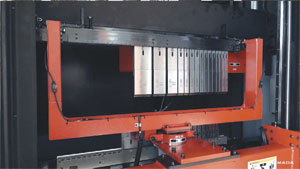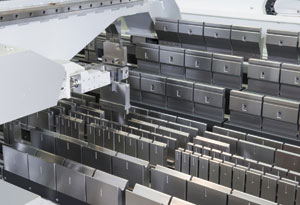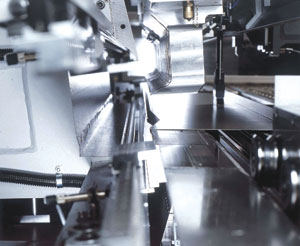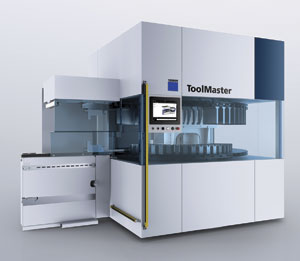by Nestor Gula
Automatic tool changers increase bending productivity
As fabricators continue to look for ways to improve productivity in an ever-increasing competitive environment, they’re turning to automation. For press brakes, that typically means automatic tool changers (ATCs).
“The tool changer may not be faster than an operator changing the tools, but the beauty of it is that the operator can then do other jobs while tools are being changed,” says Marcel Fink, TruBend sales product manager for TRUMPF Inc. With this, overall setup time can be reduced by up to 50 per cent. The productivity gain depends on how the shop was organized before and whether they were taking advantage of technologies such as automatic tool clamping and optical setup aids.”
Scott Otten, bending product manager for Amada America Inc. estimates a fabrication shop can save about 20 minutes on average.
The main reason to have an automatic tool change system on a press brake is to “reduce the amount of non-value added time.”
 Bill Bossard, president of Salvagnini America suggests asking what percentage of the day is a press brake producing a part. “You get a wide variety of answers, but typically people that have looked at their own shops have told me that it’s less than 20 per cent of the day that the machine is bending a part. So, if you can double the amount of time available for that machine to go up and down and bend a part you save one machine and one operator.”
Bill Bossard, president of Salvagnini America suggests asking what percentage of the day is a press brake producing a part. “You get a wide variety of answers, but typically people that have looked at their own shops have told me that it’s less than 20 per cent of the day that the machine is bending a part. So, if you can double the amount of time available for that machine to go up and down and bend a part you save one machine and one operator.”
The amount of tool changes a shop does per shift or per day will determine the efficiencies of an automated setup. Automated tool changing systems can be costly, but for most shops the benefits–and the ROI–that’s possible quickly outweighs those costs.
“We judge the benefit of an automated tool changing system on how many tool changes a company does per shift. At about six tool changes per shift it starts to be beneficial,” says Mike Junker, brake product manager for LVD Strippit. “And then of course the more they do after that, the easier it is as a payback. So, our wheel house is at six to eight tool changes and usually we can then justify a tool changer.”
Even if you’re performing three or four tool changes a day, there’s still a benefit to investing in an automatic tool changer. “You may not see the payback but there is some benefit for any shop,” says Otten. “They don’t need a seasoned press brake operator to run these machines. They can take anybody off the street or anywhere in their factory and put them in front of this machine and they can produce good parts, which has typically not been the case on the press brake. In the past you typically required a skilled operator.”
 Retrofitting press brakes
Retrofitting press brakes
Some older press brakes can have an automatic tool changing system integrated into the machine. Many builders and equipment fabricating integrators offer retrofit and upgrade packages that may be a good solution for shops who want to control operation costs but still gain the benefits of automated equipment.
“Our tool changer can be retrofitted to the machine later,” says Fink. “Customers can get a new machine or an already installed machine retrofitted with our tool changer. A machine that was installed six or seven years ago can receive an automated tool changer.”
Offline programming for productivity
One of the advantages of automated press brakes (and other fabricating equipment) is user friendly programming software equipment suppliers have integrated into their systems. For instance, TRUMPF’s TruTops Boost is a PC-based offline programming software that lets users write programs for upcoming jobs while the machine is still working on the current one, which reduces machine downtime.
 “We encourage customers to program offline because you can program 3D graphically,” says Amada’s Scott Otten. When an operator finishes one job, the whole system will shift to a second job, with new punches and dies and new instructions for the operator on the screen. “In the end, what the operator sees is exactly how to bend that part, a 3D image for checks running interference, things like that. They know exactly how to gauge and bend the part, so it reduces mistakes where sometimes operators have bent parts inside-out.”
“We encourage customers to program offline because you can program 3D graphically,” says Amada’s Scott Otten. When an operator finishes one job, the whole system will shift to a second job, with new punches and dies and new instructions for the operator on the screen. “In the end, what the operator sees is exactly how to bend that part, a 3D image for checks running interference, things like that. They know exactly how to gauge and bend the part, so it reduces mistakes where sometimes operators have bent parts inside-out.”
 Since materials and thicknesses change from job to job, often operators must do test bending. “They make a bend, calculate the angle, do an angle correction, things like that,” he says. “We’ve have our machines equipped with a bend indicator, a device that measures the part on the fly and adjusts the angle. No need for any test bend pieces. It will immediately come up and bend correctly.”
Since materials and thicknesses change from job to job, often operators must do test bending. “They make a bend, calculate the angle, do an angle correction, things like that,” he says. “We’ve have our machines equipped with a bend indicator, a device that measures the part on the fly and adjusts the angle. No need for any test bend pieces. It will immediately come up and bend correctly.”
If you want to improve productivity in your fabrication shop, consider today’s automation offerings for press brakes. Whether it’s retrofitting your existing press brake or purchasing a new one equipped with ATCs, chances are your fabrication shop will benefit from time and cost savings, and it will result in a more competitive operation. SMT
